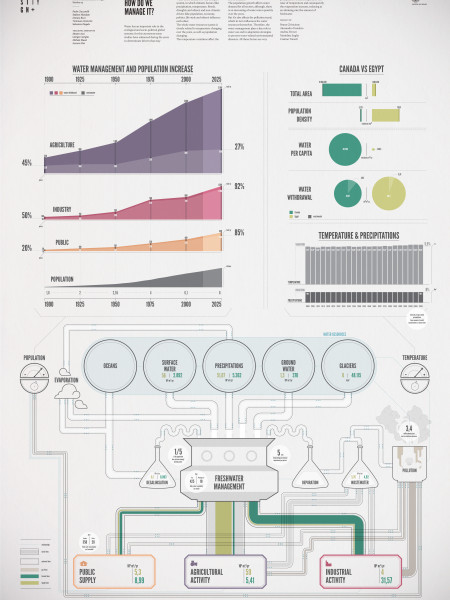
The Path To Peak Water?
The Path to Peak Water Many scientists and experts fear that humanity is reaching the point of peak water-the point at which freshwater is being con- sumed faster than it is being replenished or available. Below we take a look at the amount of water use around the world. Can we cut back before we reach the point of no return? EARTH'S FRESHWATER RESOURCES of freshwater is is stored is found in locked up as ice or underground as groundwater, soil moisture, swamp lakes and 70% 30% 0.3% permanent snow rivers. cover. water or permafrost. GLOBAL WATER WITHDRAWALS 69% 15% 80% 1% www Irrigation Electric Domestic Manufacturing Livestock DIRECT WATER USE The average person needs between 0.6 and 1.3 gallons of water per day to survive in a moderate climate. The average person in the Netherlands uses 27 gallons. The minimum amount of water The average person living in the U.S. uses 65-78 gallons of water per day. The average person in the Republic of the Gambia, Africa, uses 1.17 gallons per day. needed for drinking, cooking, bathing and sanitation is 13 gallons. VIRTUAL WATER According to the Pacific Institute, "virtual water" is water we consume indirectly. This is the water required to produce the food we eat, clothes we wear and the goods we use. 139 gallons 29 gallons 67 gallons 650 gallons of water are required for a 16-ounce cup of coffee. of water are required for a 4-ounce glass of wine. of water are required for an 8-ounce glass of orange juice. The water footprint of a cotton shirt includes the water for growing the cotton, processing and dyeing the fabric, and finishing the shirt. The amount of water required varies depending on the country, agricultural practices and processing practices, but on average an estimated 650 gallons of water is needed to produce one shirt. 13 gallons 449 gallons 2,036 gallons of water are required for one tomato. of water are required for a 100-gram chocolate bar. of water are required for one pound of beef. WATER FOOTPRINT A 2012 analysis found that the water footprint of global consumption is roughly 9 billion cubic meters per year, roughly 500 times the average annual flow of the Colorado River in its natural state. Water footprints include both direct uses of water and "virtual water." 1,258 m³/year 1,852 m2/year Russia U.K. 2,842 m³/year U.S.A. 1,071 m³/year China 1,089 m³/year India 1,167 m/year Ethiopia Democratic Republic 552 of the Congo m/year 1,101 m/year Kenya 2,027 m2/year Brazil 2,315 m³/year Australia OVERPUMPING GROUNDWATER Each year, enough water to fill 100 million Olympic-size swimming pools is being globally overpumped or withdrawn quicker than it can be replaced from underground aquifers. This is more than three times the rate 50 years ago. 150 km3 total volume of groundwater overpumped globally on an annual basis. Sources: Water Footprint Network, Pacific Institute, National Geographic, UNESCO-IHE, WaterGAP ensia Symbols designed by Alessandro Suraci, Edward Boatman and Isabel Martínez Isabel from the Noun Project. Infographic by Kylie Schultz with design by Amber Billings. OEnsia 2014 | ensia.com
The Path To Peak Water?
Publisher
EnsiaDesigner
EnsiaSource
http://ensia...eak-water/Category
EnvironmentGet a Quote











